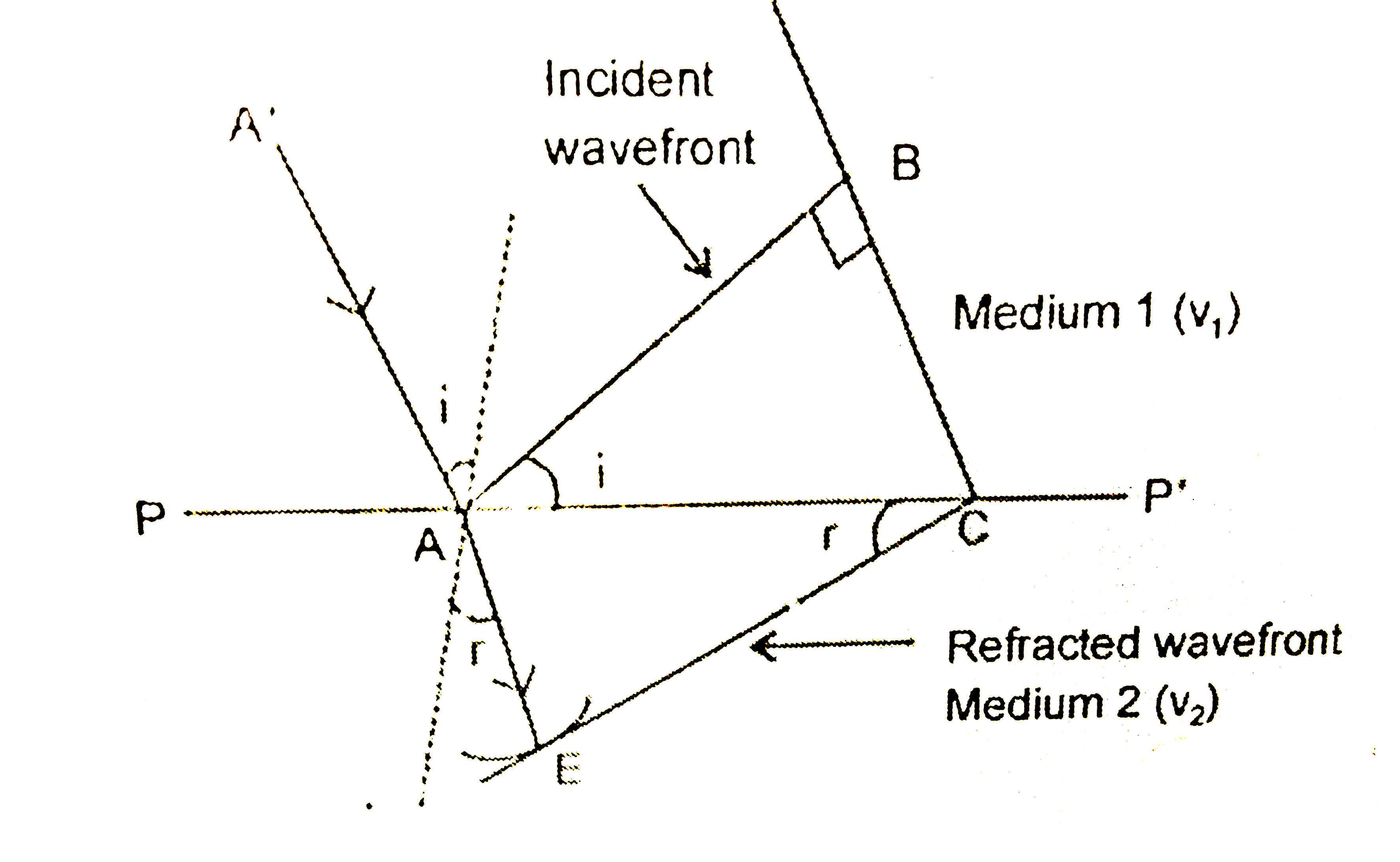Define wavefront. Draw the shape of refracted wavefront when the plane incident wave undergoes refraction from optically denser medium to rarer medium. Hence prove Snell’s law of refraction
Step-by-Step Solution:
1. Definition of Wavefront:
A wavefront is defined as the locus of all points in a medium that are vibrating in the same phase of a wave. In simpler terms, it is an imaginary surface that connects all the points that are at the same stage of vibration in a wave. For example, in a plane wave, the wavefronts are parallel planes.
2. Drawing the Shape of Refracted Wavefront:
To illustrate the shape of the refracted wavefront when a plane wavefront passes from an optically denser medium to a rarer medium, we can follow these steps:
- Draw a horizontal line to represent the boundary between the two media.
- Draw a set of parallel lines above the boundary to represent the incident wavefront in the denser medium.
- When the wavefront reaches the boundary, it will bend away from the normal as it enters the rarer medium.
- Draw a new set of parallel lines in the rarer medium that are further apart than the incident wavefront lines, indicating that the wavefront has refracted.
3. Proving Snell’s Law of Refraction:
Snell's Law states that the ratio of the sine of the angle of incidence (i) to the sine of the angle of refraction (r) is constant and is equal to the ratio of the velocities of the wave in the two media:
sinisinr=v1v2=n2n1
where n1 and n2 are the refractive indices of the two media.
- Let’s consider two points A and B on the wavefront in the denser medium and their corresponding points A' and B' in the rarer medium after refraction.
- The time taken for the wave to travel from A to A' and from B to B' is the same.
- The distances traveled in the two media can be expressed as:
- In the denser medium: d1=v1⋅t
- In the rarer medium: d2=v2⋅t
- The relationship between the angles and the distances can be derived using trigonometric relations from the geometry of the situation:
d1d2=v1⋅tv2⋅t=v1v2
- Using the definitions of sine in the context of the angles of incidence and refraction, we can relate the distances to the angles:
d1d2=sinisinr
- Equating both expressions gives us Snell's Law:
sinisinr=v1v2
A wavefront is defined as the locus of all points in a medium that are vibrating in the same phase of a wave. In simpler terms, it is an imaginary surface that connects all the points that are at the same stage of vibration in a wave. For example, in a plane wave, the wavefronts are parallel planes.
To illustrate the shape of the refracted wavefront when a plane wavefront passes from an optically denser medium to a rarer medium, we can follow these steps:
- Draw a horizontal line to represent the boundary between the two media.
- Draw a set of parallel lines above the boundary to represent the incident wavefront in the denser medium.
- When the wavefront reaches the boundary, it will bend away from the normal as it enters the rarer medium.
- Draw a new set of parallel lines in the rarer medium that are further apart than the incident wavefront lines, indicating that the wavefront has refracted.
Snell's Law states that the ratio of the sine of the angle of incidence (i) to the sine of the angle of refraction (r) is constant and is equal to the ratio of the velocities of the wave in the two media:
sinisinr=v1v2=n2n1
where n1 and n2 are the refractive indices of the two media.
- The time taken for the wave to travel from A to A' and from B to B' is the same.
- The distances traveled in the two media can be expressed as:
- In the denser medium: d1=v1⋅t
- In the rarer medium: d2=v2⋅t
- The relationship between the angles and the distances can be derived using trigonometric relations from the geometry of the situation:
d1d2=v1⋅tv2⋅t=v1v2
- Using the definitions of sine in the context of the angles of incidence and refraction, we can relate the distances to the angles:
d1d2=sinisinr
- Equating both expressions gives us Snell's Law:
sinisinr=v1v2
Topper's Solved these Questions
- BOOK - CBSE MODEL PAPERCHAPTER - SAMPLE PAPER 2022 TERM IIEXERCISE - SECTION B16videos
SAMPLE PAPER 2022 TERM II
- BOOK - CBSE MODEL PAPERCHAPTER - SAMPLE PAPER 2022EXERCISE - SECTION C6videos
SAMPLE PAPER 2022
- BOOK - CBSE MODEL PAPERCHAPTER - SAMPLE PAPER 2023 TERM IEXERCISE - SECTION D4videos
SAMPLE PAPER 2023 TERM I
Similar Questions
Knowledge Check
- Question 1 - Select One
When a ray goes from an optically rarer medium to a denser medium, it:
Agoes straightBbends away from normalCbends towards normalDreflect back - Question 2 - Select One
When the ray of light travles from an optically denser medium to optically rarer medium the maximum value of angle of refraction is
A30∘B45∘C60∘D90∘ - Question 3 - Select One or More
When a wave travels from a denser to rarer medium, then
Aspeed of wave increasesBwavelength of wave decreasesCamplitude of wave increasesDthere is no change in phase angle
The angle of refraction is always greater than the angle of incidence for a ray of light travelling from optically denser medium to a rarer medium.
View SolutionDraw the shape of wavefront when a plane wavefront in incident on (i) concave mirror and (ii) prism.
View SolutionUsing Huygen's principle construct a refracted wavefront when a plane wavefront is incident on plane surface from an optically denser meidum side. Using this figure, obtain the condition of critical angle and total internal reflection.
View SolutionWhen a light ray passes from an optically denser medium into an optically rarer medium,
View SolutionWhen wavefronts pass form denser medium to rarer medium the width of the wavefront
View Solution


